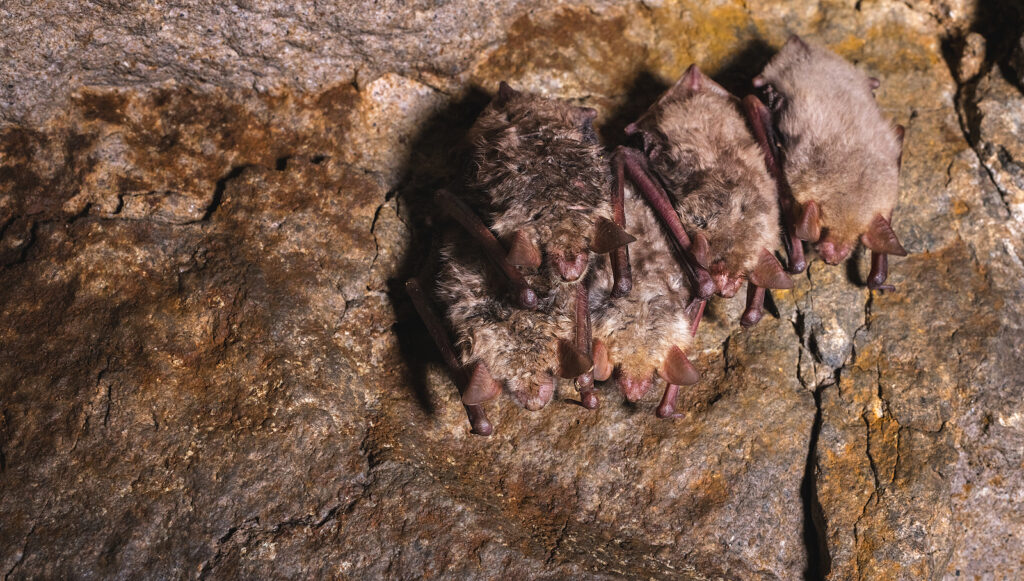There are more than 900 species of bat in the world, but only small group of specific bat species that call Tennessee home. Tennessee bats are Microchiroptera, which means they are small, nocturnal, insectivorous, Echolocating suborder of bats. Continue reading to learn which bat species are the most commonly found here in the Volunteer State, as well as, what you can do if you have a bat problem on your Nashville, Tennessee property.

Little Brown Bat (Myotis lucifugus)
Little Brown bats are part of the mouse-eared genus of bats, and commonly found in the outer parts of the state near abundant water sources like streams, creeks, ponds, rivers, and lakes. They have glossy fur coats ranging in a variety of dark browns, golds, and reds. They are only about 3 inches in length and weigh less than half an ounce at maturity. Their wings span ranges from 8 to 12 inches. During every season of moderate climate, they maintain both day and night roosts; but in winter, they use hibernation roosts.
Northern Long-Eared Bat (Myotis septentrionalis)
The Northern Long-Eared Bat is a medium-sized, insectivorous bat that is well distinguished by its long rounded ears that extend beyond the tip of their nose when laid forward. They are found in the Northern parts of Tennessee. They prefer boreal coniferous forests and wooded areas, and generally roost inside hollowed trees, underground mines, and buildings. They are an average of 3 inches in length, weight under half an ounce, and have a wingspan that can reach up to 10 inches in width. During the summer, females remain in small colonies while makes roost alone.
Evening Bat (Nycticeius humeralis)
The Evening bat is found mostly in the very Southern parts of Tennessee, and unfortunately, is a threatened species. They have a very similar appearance to the Little and Big Brown bat, so they are often confused for one another. However, you can tell an Evening bat apart by their blunt-faced tragus at the base of their ears. They are about 3 inches in length, like most microbats, and weight around a half an ounce. They have dark brown bodies and black ears, and a wingspan of up to 11 inches in width.
Hoary Bat (Lasiurus cinereus)
Hoary bats are often found in forested areas that border a large clearing. They are a solitary species that prefer dense leaf coverage above and an open area below, which is why they often choose to roost inside tree cavities or woodpecker holes. They are larger than the other bats mentioned so far, weighing an average of 1.2 ounces, and growing to an average of 5 or 6 inches in body length. They also have an impressive average wingspan of 16 to 17 inches. But they are most identifiable by their dark hairs with white tips and their yellowish-orange necks.
Big Brown Bat (Eptesicus fuscus)
The Big Brown bat is a common nuisance in Tennessee, especially in the Middle Tennessee regions. They prefer to inhabit cities and rural areas, and rarely found in heavily forested areas. Instead, they are often found roosting in barns or sheds, as well as, inside homes in double walls, boxed-in eaves, and attics. Their fur can take on a range of colors, from reddish browns to pinkish-olive colors and more, and their average body length ranges from 4 to 5 inches. They weigh just under an ounce and retain an average wingspan of 13 inches.
Indiana Bat (Myotis solidalis)
The Indiana bat is an endangered species and federal protected. There are less than 300,000 remaining in the country today. They are very similar in appearance to the Big Brown bat, as they have dark, dull colored fur. During the summer, they roost in tree cavities or under dark bridges, but when winter comes, they start looking for warmer shelter in limestone caves, buildings, and more. As a microbat, they are very small, reaching average length of 3 inches and weighing less than half an ounce. Although small in size, they retain a wingspan of 9 to 10 inches.
Silver-Haired Bat (Lasionycteris noctivagans)
The Silver-Haired bat gets its name from its dark black coat with silver or white tips. They are not the most common bat found here in Tennessee, but they are no stranger to these parts either. They typically live in coniferous and deciduous forests within range of water, like rivers, lakes, streams, estuaries, and ponds. They are not likely to roost inside homes, but have been known to roost inside buildings, hollowed trees, and more. At peak maturity, these bats can reach an average length of 3 to 4 inches, and weigh just under half an ounce. Their wingspans can reach up to 12 inches, but average around 11 inches.
Eastern Red Bat (Lasiurus borealis)
The Eastern Red bat primarily lives in heavily forested areas of the Greater Tennessee regions that are sparsely to moderately-populated by humans. They are not commonly found in heavily urbanized areas. During winter they migrate to warmer regions just as many bird species do, but in the summer, they choose to make their roosts in hollowed trees. They are average in size compared to most other Tennessee microbats, weighing between a quarter and half an ounce, and reaching lengths of 4 to 5 inches. Their fur is excellent camouflage system since they like to roost in dense foliage, and is typically dark red to yellowish-red in color with white tips.
Tennessee Bat Removal and Control You Can Trust
Call Modern Wildlife Control at 615-336-5503 for safe and humane bat removal and control in Nashville, Tennessee. Our licensed wildlife control specialists offer a wide range of residential and commercial bat extraction and exclusion services at the most competitive prices around. We only use safe, eco-friendly techniques and humane methods of bat abatement. We also offer 24 hour emergency service, free estimates, free advice, and more! Call 615-336-5503 to request a free estimate, today.

